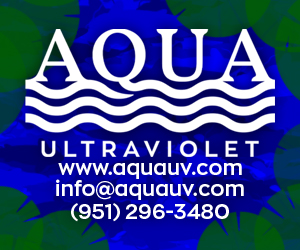 All trades, including pond-building, have one thing in common: 90 percent or more of all owners used to be a tech working for someone else. One day in the field, a little light bulb goes off and says, “Gee, the company is paying me X dollars per hour, and they are charging the customer a huge amount of money. If I went into business for myself, I could charge them the same rate —“ and I would be rich!”
All trades, including pond-building, have one thing in common: 90 percent or more of all owners used to be a tech working for someone else. One day in the field, a little light bulb goes off and says, “Gee, the company is paying me X dollars per hour, and they are charging the customer a huge amount of money. If I went into business for myself, I could charge them the same rate —“ and I would be rich!”
Over the coming months, the seed continues to grow, and one day you make the decision. You quit your job, determined to do a better job than your former boss —“ while making a lot more money! Typically, the new company owner starts out alone or perhaps with one other person. The shop is their home or garage.
So, what’s the first major challenge? How much do you charge? In reality, that’s not really a major issue, as you can simply call all over town to find out what others are charging. Their pricing becomes your pricing —“ or, rather, yours is typically a bit lower, so you can get all the jobs based solely on price.
The irony is that this initial pricing strategy actually works, for a while, at least. After all, your overhead is lower than your competition’s, so you’re making money. However, really high-quality pond builders grow. With growth comes change —“ more overhead, inventory, receivables, equipment, techs and taxes. As costs go up, profits come down, and typically within three to five years, the once highly profitable fledgling company is losing money.
Improper Pricing
This is the main cause of a business’s failure. In other words, few companies know what they really need to charge per hour for their services. Thus, putting together a reasonable bid package to cover the real costs of doing business —“ while still generating a reasonable profit —“ is lost on many new business owners.
The rest of this article will cover the basic principles of setting proper hourly rates. Be aware that this is normally a full-day seminar or workshop, so we will only hit the high points. The foundational principle of proper labor pricing is that rates need to be calculated from a cash-flow perspective, not accounting. Cash flow is concerned with the real dollars that flow in and out of the company, versus accounting numbers that sometimes use paper dollars. We will discuss some of the major differences throughout the article.
Equipment-Replacement Dollars
This is a major difference between cash flow and accounting. When a vehicle or piece of equipment is purchased, Uncle Sam typically allows the owner to write off the cost over five years, or 20 percent per year. This becomes a cost of doing business in the form of an overhead cost called depreciation. The term “equipment-replacement cost” looks at the same piece of equipment from an entirely different point of view, asking how many more years the equipment will last and how much it will cost in the future to replace. Then it builds this “future cost” into today’s pricing, so when it’s time to replace the equipment, the owner has the cash to pay for it.
[box style=”rounded” border=”full”]>> Must Read | Perks of Customer Relationship Management Software .[/box]
For example, let’s assume a vehicle was purchased three years ago for $25,000. It is estimated to last four more years, and the cost of replacement will be a net $28,000 after trade-in. This means the equipment-replacement cost would be $7,000 per year (or $28,000 over four years).
Typically, the equipment-replacement cost will be at least twice the accounting depreciation figure, since it is dealing with past costs, not future costs. The equipment-replacement cost is often a company’s second-highest single cost of doing business.
Labor: Direct and Indirect
Indirect labor covers overhead people —“ normally office staff, owners who do not work in the field and other support staff.
 Direct labor covers technicians who are working in the field. Their time is normally billed directly to the customer. Direct labor has significant amounts of non-billable time. Non-billable time is composed of shop time at the beginning and end of the day, travel time between jobs, vacation, sick days and holidays, as well as callback, warranty work and company meetings. A typical service technician making multiple calls a day will have non-billable time in the range of 50 percent. Install crews will be in the 15-to-20-percent range.
Direct labor covers technicians who are working in the field. Their time is normally billed directly to the customer. Direct labor has significant amounts of non-billable time. Non-billable time is composed of shop time at the beginning and end of the day, travel time between jobs, vacation, sick days and holidays, as well as callback, warranty work and company meetings. A typical service technician making multiple calls a day will have non-billable time in the range of 50 percent. Install crews will be in the 15-to-20-percent range.
Think about that for a moment. If you have a service tech making $18 per hour, or perhaps $20 per hour when you include company-matching taxes, that single tech is costing the company $20,000 per year, assuming 1,000 non-billable hours per year in non-billable time. But, that $20,000 needs to become part of the company’s overhead cost, just like rent, utilities and insurance.
Fixed and Variable Overhead
These are the basic costs of doing business, including gas, insurance, office supplies and so forth. However, when considering overhead costs, be sure to include the following costs that are often overlooked.
- Bad debt is money that is not and will not be collected.
- Long-term debt is past debt that needs to be paid off. This could take the form of past-due taxes, money owed to a supplier, an unpaid line of credit or personal loans. Decide how many years you want to take to pay off the debt and build the repayment cost into the overhead.
- Considering the full amount of a loan is another huge difference between cash flow and accounting. If you have a $500-per-month loan payment and $100 of it is interest, the only figure that shows up in the accounting profit-and-loss statement is the $100 interest. However, from a cash-flow perspective, the company wrote a check for $500, which flowed out of the company. If the company has a lot of loans, this can be a major reason that your accountant insists that you are making taxable income, even though there is no money in your checkbook!
Most of the time when a company purchases materials or equipment to resell to a customer, they will mark up the item to generate a net profit. The markup on the items sold can and will absorb some of the fixed and variable overhead of running the business.
[box style=”rounded” border=”full”]>> Pond Hunter Podcast Connects with Enthusiasts .[/box]
And amazingly, many company owners do not pay themselves a regular salary; they simply take money out when needed. Well, guess what? If you don’t build costs like rent, utilities and insurance into your customer pricing, it won’t get covered. Likewise, if you don’t build your salary into your cost of doing business, it won’t get covered, either. Put together a family budget to determine what salary you need to earn, and then build it in to your cost of doing business as indirect labor.
Setting Profitable Hourly Rates
First, calculate the company’s total equipment-replacement costs by listing all vehicles and equipment with more than $1,000 in value. This will become one of your fixed overhead costs a bit later.
Next, total all indirect labor costs, and be sure to include your costs of matching taxes (Social Security, federal unemployment tax and your state’s unemployment tax). When it comes to direct labor, determine the cost of non-billable time, which will become an overhead cost. Also compute the actual number of billable hours to the customer (or the total hours the company pays for, less non-billable hours). Finally, determine the weighted average hourly rate of all direct labor personnel.
Add up the real cost of doing business, including fixed and variable overhead, direct and indirect labor, cost of non-billable time, full amount of loan payments, equipment-replacement costs and matching taxes. Then, project how much gross profit will be generated through the sale of materials and equipment over the coming year.
Next, you can calculate the overhead rate per hour. Take the total cost of doing business calculated above and subtract the projected gross profit. Then, divide the remaining number by the billable hours you have determined. For the sake of example, let’s say your overhead rate is calculated at $48.78 per hour.
Then, you must determine the break-even hourly rate, or the rate you would need to cover all the company’s costs of doing business without a net profit. This is determined by combining the overhead rate per hour ($48.78) with the average hourly rate of your direct-labor people. If the average rate were perhaps $16.53, the sum, or break-even rate. would be $65.31.
Your final rate is determined by adding profit. Let’s assume the company wants a 15-percent net profit, so your hourly rate would then be $65.31 divided by 85 percent, or $76.83 per hour.
In its simplest form, that is the process.



Thank you, great project advice!
Great advise I feel like I could do the same thing and not be part of that 90% Thanks!